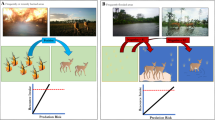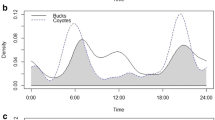Abstract
Increased group size is predicted to dilute predation risk for individuals and increase predator detection at the group level. Individual vigilance tends to decrease with group size for many species. However, this pattern varies across species, context, space, and time. We explored the effects of group size on vigilance behaviors of white-tailed deer (Odocoileus virginianus) in relation to season, sex-age status, group composition, diminishing food returns, and intraspecific competition. We used classical behavioral observation methods and camera traps to study deer behavior. Sex-age class, season, intraspecific competition, and diminishing food returns interacted with group size to shape vigilance behaviors in deer. During spring, the effect of group size was essentially non-existent, and during winter, vigilance patterns exhibited a non-linear relationship with group size. Subadult deer benefited most in terms of increased foraging and decreased vigilance from the presence of 1–2 conspecifics, likely a maternal family group. This effect diminished in the presence of additional conspecifics (≥3), apparently as a function of contest competition. Individual deer spent less time at a site in areas with greater intraspecific abundance; however, in the presence of conspecifics, the relationship was reversed. Our research suggests that maternal family groups play an important seasonal role in vigilance behaviors of deer. Our study demonstrates the complex effects of group size in white-tailed deer. Group size effects are generally considered to be in response to changes in predation risk; however, our work supports a growing body of evidence that group size effects may also be influenced by intraspecific interactions.




Similar content being viewed by others
Data availability
Data will be made available in a public data repository once the manuscript is accepted.
References
Adelman JS, Moyers SC, Farine DR, Hawley DM (2015) Feeder use predicts both acquisition and transmission of a contagious pathogen in a North American songbird. Proc R Soc B 282:20151429
Altmann J (1974) Observational study of behavior: sampling methods. Allee Laboratory of Animal Behavior, University of Chicago, Chicago, Illinois, USA. Rec. 15-III-1973
Barton K (2018) MuMIn: Multi-model inference. R package version 1.42.1. https://CRAN.R-project.org/package=MuMIn
Beauchamp G (2001) Should vigilance always decrease with group size? Behav Ecol Sociobiol 51:47–52
Beauchamp G (2008) What is the magnitude of the group-size effect on vigilance? Behav Ecol. https://doi.org/10.1093/beheco/arn096
Beauchamp G, Livoreil B (1997) The effect of group size on vigilance and feeding rate in spice finches (Lonchura punctualata). Can J Zool 75:1526–1531
Beauchamp G, Ruxton GD (2003) Changes in vigilance with group size under scramble competition. Am Nat 161(4):672–675
Beauchamp G, Zhongqiu L, Yu C, Bednekoff PA, Blumstein DT (2021) A meta-analysis of group-size effect on vigilance in mammals. Behav Ecol 32(5):919–925
Bengsen AJ, Leung LKP, Lapidge SJ, Gordon IJ (2011) Using a general index approach to analyze camera trap abundance indices. J Wildl Manag 75(5):1222–1227
Bridges AS, Noss AJ (2011) Behavior and activity patterns. In: O’Connell AF et al (eds) Camera traps in animal ecology: methods and analyses. Springer
Burnham KP, Anderson DR (1998) Model selection and inference: a practical information-theoretical aproach. Springer-Verlag, New York, USA
Catterall CP, Elgar MA, Kikkawa J (1992) Vigilance does not covary with group size in an island population of silvereyes (Zosterops lateralis). Behav Ecol 2:207–210
Charnov EL (1976) Optimal foraging, the marginal value theorem. Theor Popul Biol 9(2):129–136. https://doi.org/10.1016/0040-5809(76)90040-X. PMID:1273796
Cherry MJ, Conner LM, Warren RJ (2015) Effects of predation risk and group dynamics on white-tailed deer foraging behavior in a longleaf pine savanna. Behav Ecol 26:1091–1099
Childress MJ, Lung MA (2003) Predation risk, gender and the group size effect: does elk vigilance depend upon the behaviour of conspecifics? Anim Behav 66:389–393
Clare JDJ, Zuckerberg B, Liu N, Stenglein JL, Van Deelen TR, Pauli JN (2023) A phenology of fear: investigating scale and seasonality in predator-prey games between wolves and white-tailed deer. Ecology. https://doi.org/10.1002/ecy.4019
Creel S, Schuette P, Christianson D (2014) Effects of predation risk on group size, vigilance, and foraging behavior in an African ungulate community. Behav Ecol. https://doi.org/10.1093/beheco/aru050
Elgar MA (1989) Predator vigilance and group size in mammals and birds: a critical review of the empirical evidence. Biol Rev 64:13–33
Favreau FR, Goldizen AW, Pays O (2010) Interactions among social monitoring, anti-predator vigilance and group size in eastern grey kangaroos. Proc R Soc B 277:2089–2095
FitzGibbon CD (1990) Mixed-species grouping in Thomson’s and Grant’s gazelles: the antipredator benefits. Anim Behav 39:1116–1126
Flagel DG, Belovsky GE, Beyer DE Jr (2015) Natural and experimental tests of trophic cascades: gray wolves and white-tailed deer in a Great Lakes forest. Community Ecol. https://doi.org/10.1007/s00442-015-3515-z
Foster WA, Treherne JE (1981) Evidence for the dilution effect in the selfish herd from fish predation on a marine insect. Nature 293:466–467
Gulsby WD, Cherry MJ, Johnson JT, Conner LM, Miller KV (2018) Behavioral response of white-tailed deer to coyote predation risk. Ecosphere 9(3). https://doi.org/10.1002/ecs2.2141
Higdon S, Diggins CA, Cherry MJ, Ford WM (2019) Activity patterns and temporal predator avoidance of white-tailed deer (Odocoileus virginianus) during the fawning season. J Ethol. https://doi.org/10.1007/s10164-019-00599-1
Hogan BG, Hildenbrandt H, Scott-Samuel NE, Cuthill IC, Hemelrijk CK (2017) The confusion effect when attacking simulated three-dimentional starling flocks. R Soc Open Sci 4(1):160564. https://royalsocietypublishing.org/doi/10.1098/rsos.160564
Kenward RE (1978) Hawks and doves: Factors affecting success and selection in goshawk attacks on woodpigeons. J Anim Ecol 47(2):449–460
Kuijper DPJ, Verwijmeren M, Churski M, Zbyryt A, Schmidt K, Jędrezejewska B, Smit C (2014) What cues do ungulates use to assess predation risk in dense temperate forests? PLoS ONE 9:e84607
Lashley MA, Chitwood MC, Biggerstaff MT, Morina DL, Moorman CE, DePerno CS (2014) White-tailed deer vigilance: the influence of social and environmental factors. PLoS ONE 9(3):e90652. https://doi.org/10.1371/journal.pone.0090652
Li C, Jiang Z, Li L, Li Z, Fang H, Li C, Beauchamp G (2012) Effects of reproductive status, social rank, sex, and group size on vigilance patterns in Przewalski’s gazelle. PLoS ONE 7(2):e32607. https://doi.org/10.1371/journal.pone.0032607
Liley S, Creel S (2007) What best explains vigilance in elk: characteristics of prey, predators, or the environment? Behav Ecol 245–254
Lima SL (1994) On the personal benefits of anti-predatory vigilance. Anim Behav 48:734–736
Lima SL, Dill LM (1990) Behavioral decisions made under the risk of predation: a review and prospectus. Can J Zool 68:619–639
Lipetze VE, Bekoff M (1982) Group size and vigilance in pronghorns. Z Tierpsychol 58:203–216
Lung MA, Childress MJ (2007) The influence of conspecifics and predation risk on the vigilance of elk (Cervus elaphus) in Yellostone National Park. Behav Ecol. https://doi.org/10.1093/beheco/arl066
Michelena P, Pillot M, Henrion C, Toulet S, Boissy A, Bon R (2012) Group size elicits specific physiological response in herbivores. Biol Lett 8:537–539. https://doi.org/10.1098/rsbl.2012.0197
Nixon CM, Hansen LP, Brewer PA, Chelsvig JE (1991) Ecology of white-tailed deer in an intensively farmed region of Illinois. Wildl Monogr 118:3–77
Olson ER (2013) As a wolf: a Wisconsin case-study of wolf-human conflict and predator-prey ecology. Dissertation. University of Wisconsin – Madison, Madison, Wisconsin, USA
Olson ER, Van Deelen TR, Ventura SJ (2019) Variation in anti-predator behaviors of white-tailed deer (Odocoileus virginianus) in a multi-predator system. Can J Zool 97:1030–1041. https://doi.org/10.1139/cjz-2018-0254
Pecorella I, Fattorini N, Macchi E, Ferretti F (2019) Sex/age differences in foraging, vigilance and alertness in a social herbivore. Acta Ethol. https://doi.org/10.1007/s10211-018-0300-0
Pinheiro J, Bates D, DebRoy S, Sarkar D, EISPACK authors, Heisterkamp S, Van Willigen B, R-core (2018) Package ‘nmle’: linear and nonlinear mixed effects models. Where. R package version 3.1–137. https://CRAN.R-project.org/package=nmle
Pulliam HR (1973) On the advantages of flocking. J Theor Biol 38:419–422
Quenette PY (1990) Functions of vigilance in mammals: a review. Acta Oecol 11:801–818
R Development Core Team (2018) R: A language and environment for statistical computing. R Foundation for Statistical Computing, Vienna, Austria. ISBN 3-900051-07-0. http://www.R-project.org
Roberts G (1996) Why individual vigilance declines as group size increases. Anim Behav 51:1077–1086
Sikes RS, Animal Care and Use Committee of the American Society of Mammalogists (2016) 2016 guidelines of the American Society of Mammalogists for the use of wild mammals in research and education. J Mammal 97(3):663–688. https://doi.org/10.1093/jmammal/gyw078. PMID:2969246
Smith JA, Suraci JP, Hunter JS, Gaynor KM, Keller CB, Palmer MS, Atkins JL, Castañeda I, Cherry MJ, Garvey PM, Huebner SE, Morin DJ, Teckentrup L, Weterings MJA, Beaudrot L (2020) Zooming in on mechanistic predator-prey ecology: integrating camera traps with experimental methods to reveal the drivers of ecological interactions. J Animal Ecol 89:1997–2012. https://doi.org/10.1111/1365-2656.13264
Thompson AK, Samuel MD, Van Deelen TR (2008) Alternative feeding strategies and potential disease transmission in Wisconsin white-tailed deer. J Wildl Manage 72:416–421. https://doi.org/10.2193/2006-543
Van Deelen TR, Campa H III, Hamady M, Haufler JB (1998) Migration and seasonal range dynamics of deer using adjacent deeryards in northern Michigan. J Wildl Manag 62(1):205–213
Vander WE, van Beest FM, Brook RK (2013) Desnity-dependent effects of group size are sex-specific in a gregarious ungulate. PloS ONE 8:e53777
Webster MM, Rutz C (2020) How STRANGE are your study animals? Nature 582:337–340
Whiteside MA, Langely EJG, Madden JR (2016) Males and females differentially adjust vigilance levels as group size increases: effect on optimal group size. Anim Behav 118:11–18. https://doi.org/10.1016/j.anbehav.2016.04.025
Winnie J Jr, Creel S (2007) Sex-specific behavioral responses of elk to spatial and temporal variation in the threat of wolf predation. Anim Behav 73:215–225
Acknowledgements
We are indebted to many folks who supported this project in various ways. Special thanks to two anonymous reviewers and Associate Editor Julia Lehmann for their feedback on an earlier version of this manuscript. We want to specifically thank Lucas Olson for his assistance with camera trap data entry. Special thanks to R. Olson, L. Olson, H. Campos, A. Smetna. Dr. S. J. Ventura, A. Wydeven, and Dr. D. Waller for guidance. The following agencies kindly provided access to their lands for this research, including Black River Falls State Forest, Chequamegon-Nicolet National Forest, Wood County Forest, and multiple private property owners. This research was funded, in part, through an NSF-IGERT Certificate for Humans and the Global Environment (CHANGE) Program Fellowship awarded to ERO, with additional support from the UW-Madison Graduate School, the Nelson Institute for Environmental Studies, the Derse Foundation, and Northland College (Sigurd Olson Professorship in Natural Resources, Peters Professorship in Biology, and Sabbatical funding awarded to ERO).
Funding
This research was funded, in part, through an NSF-IGERT Certificate for Humans and the Global Environment (CHANGE) Program Fellowship awarded to ERO, with additional support from the UW-Madison Graduate School, the Nelson Institute for Environmental Studies, the Derse Foundation, and Northland College (Sigurd Olson Professorship in Natural Resources, Peters Professorship in Biology, and Sabbatical funding awarded to ERO).
Author information
Authors and Affiliations
Contributions
ERO and TRV conceived study design and analytical approach. ERO implemented fieldwork, ran analyses, and drafted first version of manuscript. TRV assisted with data interpretation and drafting of manuscript.
Corresponding author
Ethics declarations
Ethics approval
This work was done according to a protocol approved by the University of Wisconsin – Madison Animal Care and Use Committee (Protocol #L429). This work was also done in accordance with the American Society of Mammalogists Guidelines for the Use of Animals (Sikes and the Animal Care and Use Committee of the American Society of Mammalogists 2016).
Conflict of interest
The authors declare no competing interests.
Additional information
Publisher's Note
Springer Nature remains neutral with regard to jurisdictional claims in published maps and institutional affiliations.
Rights and permissions
Springer Nature or its licensor (e.g. a society or other partner) holds exclusive rights to this article under a publishing agreement with the author(s) or other rightsholder(s); author self-archiving of the accepted manuscript version of this article is solely governed by the terms of such publishing agreement and applicable law.
About this article
Cite this article
Olson, E.R., Van Deelen, T.R. Competition and sex-age class alter the effects of group size on vigilance in white-tailed deer Odocoileus virginianus. acta ethol 27, 39–50 (2024). https://doi.org/10.1007/s10211-023-00430-8
Received:
Revised:
Accepted:
Published:
Issue Date:
DOI: https://doi.org/10.1007/s10211-023-00430-8




